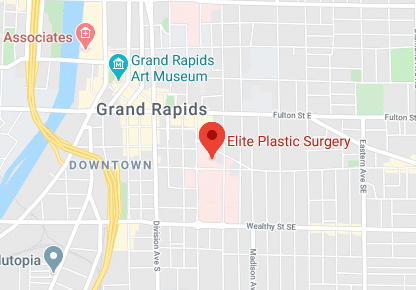
The face is usually the first place we start to notice the effects of gravity, sun exposure, life stresses, and our genetics. These factors can cause deep creases on the cheeks, a jowly, ill-defined jawline, sagging skin, and fat under the chin and around the neck — to name a few of the issues that send people to the plastic surgeon.
“Very friendly and empathetic staff, professional and courteous, prompt & efficient yet not rushed. Various treatment options presented, not pushy to treat issue as to what doctor wants, more interested in treatment that patient feels best for the patient needs & wishes.”
What is a Facelift?

A facelift, or rhytidectomy, is a surgical procedure that can help erase signs of aging by removing excess fat, tightening underlying muscles, and literally re-draping face and neck skin. The procedure can simultaneously remove and tighten sagging skin, reduce the appearance of wrinkles and return the face to a more youthful, contoured appearance.
A facelift can also be done in conjunction with other procedures related to the aging face, such as a brow lift or eyelid lift.
Types of Facelifts
This is a common question with a somewhat complicated answer, as facelifts come with so many variations, techniques, and titles. As a general rule, surgical facelifts differ by the type of incision, the number of tissue layers treated, the areas of the face targeted, and the degree of invasiveness. There are many different names and approaches for facial procedures collectively called facelifts, but they all basically fall into one of two main categories:
- The Mini Facelift (MACS. Short Scar, S-Shape, Mid-face)
- The Full Facelift (SMAS, Deep Plane, Open, Traditional)
Mini Facelift
Facial tissue is lifted and re-suspended using minimal, small incisions that can be hidden by the ear and hairline. The mini-lift is designed to improve the appearance of smile lines, jowls, and loose skin, but provides less dramatic results than a full facelift. The procedure can be performed fairly quickly under local anesthesia in an office setting.
Full Facelift
Facial tissue is repositioned, tightened, and secured in its lifted position with sutures and/or tissue glue. Fat is also often removed or repositioned as part of this procedure. The incision begins at the temple behind the hairline and continues down in front of the ear, circles around the earlobe and back, ultimately camouflaged by skin creases. A traditional facelift requires more incisions and recovery time but can deliver enhanced and longer-lasting results.
The right choice for can be based on your surgeon’s recommendations considering such specifics as: your facial anatomy and aesthetic goals, downtime and recovery preferences and risks involved.
What are the benefits of a Facelift procedure?
The facelift is beneficial for patients who are interested in correcting mild to severe signs of aging. This procedure can restore more definition along the chin and jawline by eliminating jowls and excess fat. It can eradicate excess fat and sagging skin beneath the chin and in the upper neck region and can restore contours across the midface. These physical improvements lend to an increase in confidence and satisfaction with appearance. Facelift surgery achieves the longest-lasting results of current facial rejuvenation procedures and requires only about two weeks of downtime.
Before and After Facelift Photos:
*Individual results may vary
View more before & after photos
Who are the Ideal Candidates for Facelift Surgery?
In order to achieve successful outcomes, it’s important that facelift candidates are in good overall health and have realistic expectations about results. Other factors that can affect patient suitability include:
- Skin elasticity
Successful healing with optimal results depends on having skin that is able to conform to its new, improved contours. So it’s best if the skin still retains some of its natural suppleness and elasticity. - Well-defined bone structure
Patients with less distinct features and underlying bone structure may benefit from facial implants instead of, or in addition to, a facelift. - Commitment to recovery time and care instructions
Optimal outcomes are possible when facelift patients follow all post-procedure instructions and are prepared for the time it takes to realize the final results.
About Your Facelift Procedure:
Traditional facelift surgery is performed in a hospital or outpatient surgical center. Depending on the specific type of procedure, your surgeon will use either general or regional anesthesia (nerve block), and one of these two surgical approaches:
- Minimally invasive involves smaller incisions and can provide a more subtle change in appearance. The procedure generally allows for faster recovery time and less pain than open surgery, as it causes reduced trauma to the tissue.
- Open surgery involves making a larger incision from the temple, around the ear to the lower scalp. Though open surgery can require a longer and more uncomfortable recovery, it can also be the most effective option for some patients.
Your surgeon will advise you as to which procedure is best for you, as well as the length of hospital stay based on various factors such as age, medical history, general health, and even personal preference.
What is a good age for a facelift?
Facelift surgery can be an appropriate procedure for adults in their 40s, 50s, 60s, and older. It isn’t age that a surgeon analyzes so much as it is each person’s circumstances. Facial aging may progress more quickly in some people, making them an ideal candidate for a facelift in their mid-forties. In addition to consulting with patients about their concerns and desired outcome, our board-certified plastic surgeons conduct a full medical history and evaluation to confirm good health and the optimal potential for a smooth recovery.
How long does a Facelift procedure take?
The facelift procedure can take from 2 to 4 hours. The length of the procedure is determined by the type of facelift selected and the inclusion of additional procedures, such as blepharoplasty.
How Long Is Recovery After Facelift Surgery?
Facelift surgery recovery varies, depending on the procedure, the technique used, and the patient’s unique physical and psychological healing characteristics. Generally speaking, patients feel fairly good in four or five days. Full recovery can take three to six months, with most patients saying they are comfortable going out in public in one to two weeks, or when the majority of bruising and swelling have resolved. In addition:
- A bandage might be placed around the face to minimize swelling and bruising and can be removed according to your surgeon’s instructions.
- Tubes may be present when you go home to drain excess blood and fluid and should stay in place until removed at your follow-up visit.
Specific recovery instructions will include how to care for the surgical site and drains, medications to apply or take orally, problems to watch for, and when to have follow-up appointments.
How long will my Facelift results last?
Generally, the more extensive the facelift is, the longer the improvements will last. For example, a full facelift may last up to 15 years. More subtle procedures like the mini facelift may last from 2 to 6 years. The type of facelift is only one factor that can influence how long results last. Additional factors include:
- Patient age at the time of surgery. Studies suggest that younger patients in their 40s or 50s tend to enjoy longer-lasting results.
- Additional procedures. Patients may choose to combine their facelift with other procedures, such as a brow lift or blepharoplasty, to maximize rejuvenation and extend their results.
- Lifestyle. People who are generally healthy, eat well, take good care of their skin, and prioritize sun protection typically enjoy lasting results from facelift surgery.
Tips for maximizing your facelift include:
- Select an experienced, board-certified surgeon who performs several facelifts a year.
- Follow your post-operative instructions.
- Wear sunscreen every day. Wear a hat on especially sunny days.
- Avoid alcohol and tobacco. These dehydrate and degrade the skin more quickly.
- Stay hydrated by drinking at least 64 ounces of water daily and using a high-quality moisturizer.
- Maintain a healthy weight.
- Support aging skin with non-surgical treatments like facials, chemical peels, injectables, and other procedures.
How soon after Facelift Surgery can I resume normal activities?
The timeline for returning to “normal” activities varies based on the procedure and the individual, but in general, patients should be up and moving after the effects of the anesthesia have worn off and vital signs are stable.
- After ten days to two weeks — return to office work
- After one week — leisurely walking
- About ten days to two week – brisk walking
- After two weeks – light jogging or another aerobic exercise
- In three weeks – slowly reintroduce weight lifting
- In six weeks – more vigorous activities
Are There Risks to a Facelift Procedure?
Facelifts are considered one of the safest cosmetic procedures, but all surgery comes with some common risks, including anesthesia side effects, bleeding, and infection.
Facelift surgery brings some specific risks and complications that can be temporary or permanent, including:
- Nerve injury to facial muscles
- Healing problems, more common for smokers
- Obvious scarring
- Numbness or tingling around incisions
- Hair loss at incision sites
- Skin discoloration
- Blood or fluid retention
Are Facelifts Covered by Insurance?
Insurance companies typically do not cover the costs associated with facelift procedures. This surgery is done for cosmetic reasons so is not deemed medically necessary.
How much does a Facelift cost?
Several factors influence the cost of facelift surgery, including the type of facelift a patient has done. Additional factors include surgical center fees, anesthesia, medical supplies, and ancillary procedures a patient chooses to incorporate into their treatment plan. Our team sits with you after your consultation to outline the details of your proposed treatment, including the costs of individual services.
Schedule a consultation
Your surgeon should discuss all possible complications and risks of facelift surgery during your initial consultation appointment with our Elite Plastic Surgeons. At that time, the doctor will be able to advise you as to whether a facelift is a right procedure for you, or if an alternate treatment or surgery might be preferable. Elite Plastic Surgery proudly serves Grand Rapids MI and surrounding areas. Contact us at (616) 459-1907 to schedule an appointment today!





